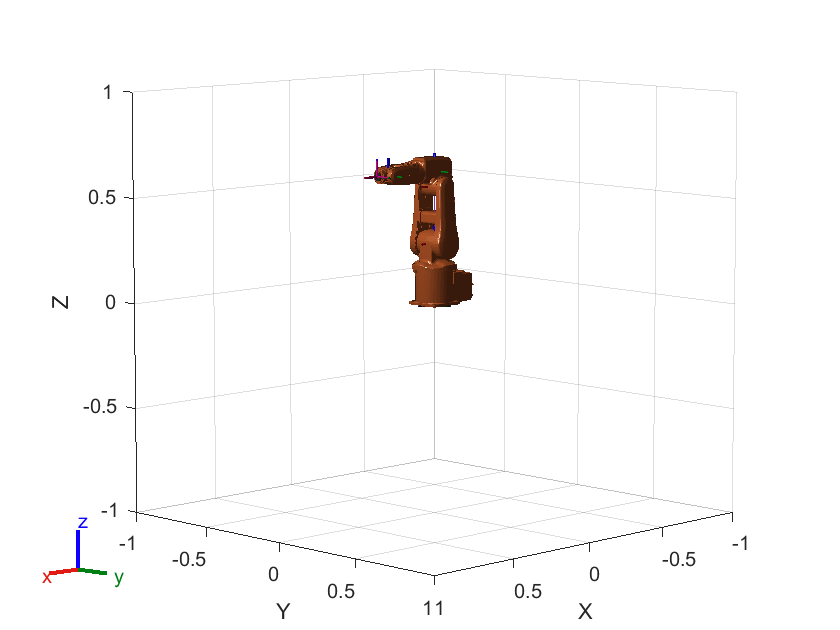writefile
Description
writefile( generates a unified robot
description format (URDF) file for the rigid body tree robot model specified in the exporter)urdfExporter
object exporter.
writefile(___,
specifies additional options using one or more name-value pair arguments in addition to the
input argument in the previous syntax.Name=Value)
Examples
This example shows how to load a robot as a rigidBodyTree model and export the robot details as a URDF file.
Load a rigidBodyTree robot model. The rigidBodyTree object contains kinematic and dynamic constraints and visual meshes for the specified robot geometry.
robotRBT = loadrobot("abbIrb120");Create a rigidBody object with a unique name.
body1 = rigidBody("link1");By default, the rigidBody object comes with a fixed joint. Replace the joint by assigning a new rigidBodyJoint object to the body1.Joint property.
body1.Joint = rigidBodyJoint(jnt1="revolute");Add the rigidBody object to the rigidBodyTree robot model. Specify the body name to which you are attaching the rigid body. Use the base name of the tree for the first body.
basename = robotRBT.BaseName; addBody(robotRBT,body1,basename);
Confirm that the rigid body and joint are correct by using showdetails.
showdetails(robotRBT)
-------------------- Robot: (9 bodies) Idx Body Name Joint Name Joint Type Parent Name(Idx) Children Name(s) --- --------- ---------- ---------- ---------------- ---------------- 1 base base_link-base fixed base_link(0) 2 link_1 joint_1 revolute base_link(0) link_2(3) 3 link_2 joint_2 revolute link_1(2) link_3(4) 4 link_3 joint_3 revolute link_2(3) link_4(5) 5 link_4 joint_4 revolute link_3(4) link_5(6) 6 link_5 joint_5 revolute link_4(5) link_6(7) 7 link_6 joint_6 revolute link_5(6) tool0(8) 8 tool0 joint6-tool0 fixed link_6(7) 9 link1 jnt1 revolute base_link(0) --------------------
Visualize the robot model.
show(robotRBT)

ans =
Axes (Primary) with properties:
XLim: [-1 1]
YLim: [-1 1]
XScale: 'linear'
YScale: 'linear'
GridLineStyle: '-'
Position: [0.1300 0.1100 0.7750 0.8150]
Units: 'normalized'
Show all properties
Add visuals to the robot model.
body9 = robotRBT.Bodies{9};
addVisual(body9,box=[0.1 0.1 0.1]);Visualize the robot model with the added visuals.
show(robotRBT)

ans =
Axes (Primary) with properties:
XLim: [-1 1]
YLim: [-1 1]
XScale: 'linear'
YScale: 'linear'
GridLineStyle: '-'
Position: [0.1300 0.1100 0.7750 0.8150]
Units: 'normalized'
Show all properties
Create a URDF exporter object. Package the mesh and URDF details in one folder.
exporter = urdfExporter(robotRBT); exporter.ExportMesh = true;
Write the packaged mesh and URDF details into the specified file.
writefile(exporter,OutputfileName="abbIrb120.urdf")Input Arguments
URDF exporter specified as a urdfExporter object.
Name-Value Arguments
Specify optional pairs of arguments as
Name1=Value1,...,NameN=ValueN, where Name is
the argument name and Value is the corresponding value.
Name-value arguments must appear after other arguments, but the order of the
pairs does not matter.
Example: writefile(exporter,
OutputfileName="abbIrb120.urdf")
Name of the generated URDF file, specified as a string scalar or character vector. You can also specify this input as a pathname corresponding to the location at which you want to generate the URDF file.
Example: "abbIrb120.urdf",
"C:/URDF/abbIrb120.urdf"
Data Types: char | string
Robot name attribute corresponding to the robot name tag in the
generated URDF file, specified as a string scalar or character vector. The function
returns as a valid robot model name such as "abbIrb120",
"abbIrb120T", "abbIrb1600".
Example: "abbIrb120"
Data Types: char | string
Option to enable mesh file export, specified as a numeric or logical value of
0 (false) or 1 (true). The generated ZIP
package contains the output URDF files and mesh files.
Data Types: logical | numeric
Maximum permissible difference in the values under tags in exported URDF,
specified as a positive scalar. The default value is sqrt(eps),
where eps returns the distance from 1.0 to the
next largest double-precision number, which is equal to
2-52. For more information, see
eps.
Data Types: single | double
Version History
Introduced in R2023b
MATLAB Command
You clicked a link that corresponds to this MATLAB command:
Run the command by entering it in the MATLAB Command Window. Web browsers do not support MATLAB commands.
选择网站
选择网站以获取翻译的可用内容,以及查看当地活动和优惠。根据您的位置,我们建议您选择:。
您也可以从以下列表中选择网站:
如何获得最佳网站性能
选择中国网站(中文或英文)以获得最佳网站性能。其他 MathWorks 国家/地区网站并未针对您所在位置的访问进行优化。
美洲
- América Latina (Español)
- Canada (English)
- United States (English)
欧洲
- Belgium (English)
- Denmark (English)
- Deutschland (Deutsch)
- España (Español)
- Finland (English)
- France (Français)
- Ireland (English)
- Italia (Italiano)
- Luxembourg (English)
- Netherlands (English)
- Norway (English)
- Österreich (Deutsch)
- Portugal (English)
- Sweden (English)
- Switzerland
- United Kingdom (English)